Abstract
Assessment was made of residual ratio of North Pacific Intermediate Water (NPIW) produced in subpolar region of the North Pacific using chlorofluorocarbons, CFC-11 and CFC-12 (CCl3F and CCl2F2), along 175°E. NPIW on density horizons less than 26.80σθ remained more than 80% north of 30°N. It was suggested that new NPIW laterally spreads over the northern North Pacific without hardly being diluted by the surroundings. For density horizons greater than 26.80σθ north of 30°N, NPIW remained less than 60%. The difference in the residual ratio between <26.80σθ and >26.80σθ north of 30°N suggests that NPIW is produced on density horizons less than 26.80σθ, which contacts the atmosphere in the subpolar region, and that NPIW is diluted by upwelling deep water on density horizons greater than 26.80σθ in high latitude of the North Pacific. NPIW on a density horizon of 26.80σθ remained about 50% south of 30°N. The decrease in the horizontal distribution of the residual ratio of NPIW suggests that half the new NPIW produced in the subpolar region is laterally spread over the North Pacific with the southward movement of NPIW.
Similar content being viewed by others
References
Broecker, W. S. (1974): “NO”, a conservative water-mass tracers.Earth Planet. Sci. Lett.,23, 100–107.
Broecker, W. S. and T. H. Peng (1982):Tracers in the Sea. Eldigio Press., Columbia Univ., New York, 690 pp.
Broecker, W. S., S. Blaton, W. M. Smethie, Jr. and H. G. Ostlund (1991): Radiocarbon decay and oxygen utilization in the deep Atlantic Ocean.Global Biogeochem. Cycles.,5, 87–117.
Bullister, J. L. and R. F. Weiss (1988): Determination of CCl3F and CCl2F2 in seawater and air.Deep-Sea Res.,35, 839–853.
Doney, S. C. and J. L. Bullister (1992): A chlorofluorocarbon section in the eastern North Atlantic.Deep-Sea Res.,39, 1857–1883.
Fine, R. A., J. L. Reid and H. G. Ostlund (1981): Circulation of tritium in the Pacific Ocean.J. Phys. Oceanogr.,11, 3–14.
Kitani, K. (1973): Structure of the water mass in the Okhotsk: particularly in regard to cold waters.Bull. Far. Seas Fish. Res. Lab.,9, 45–77.
Levitus, S. (1982): Climatological atlas of the world oceans. NOAA Prof. Paper, 13, Rockville, Maryland, 173 pp.
Ohtani, K. (1989): The role of the sea of Okhotsk on the formation of the Oyashio Water.Sea and Sky,65, 63–83 (in Japanese with English abstract).
Reid, J. L. (1965): Intermediate Waters of the Pacific Ocean.The Johns Hopkins Oceanogr. Study,2, 85 pp.
Smethie, W. M., Jr., D. W. Chipman, J. H. Swift and P. Koltermann (1988): Chlorofluoromethanes in the Arctic Mediterranean seas: evidence for formation of bottom water in the Eurasian Basin and deep-water exchange through Fram Strait.Deep-Sea Res.,35, 347–369.
Tally, L. D. (1988): Potential vorticity distribution in the North Pacific.J. Phys. Oceanogr.,18, 89–106.
Tally, L. D. (1991): An Okhotsk Sea water anomaly: implications for ventilation in the North Pacific.Deep-Sea Res.,38, 171–190.
Tsunogai, S. (1987): Deep-water circulation in the North Pacific deduced from Si−O diagrams.J. Oceanogr. Soc. Jpn.,43, 77–87.
Tsunogai, S., T. Ono and S. Watanabe (1993): Increase on total carbonate in the western North Pacific water and a hypothesis on missing sink of anthropogenic carbon.J. Oceanogr.,49, 305–315.
Pickart, R. S., N. G. Hogg and W. M. Smethie, Jr. (1989): Determining the strength of the deep western boundary current using the chlorofluoromethane ratio.J. Phys. Oceanogr.,19, 940–951.
VanScoy, K. M., R. A. Fine and H. G. Ostlund (1991): Two decades of mixing tritium into the North Pacific Ocean.Deep-Sea Res.,38, Suppl. 1, S191-S219.
Warner, M. J. and R. F. Weiss (1985a): Vertical distributions of anthropogenic chlorofluoromethanes in the North Pacific along 24°N and 47°N.EOS,66, 928.
Warner, M. J. and R. F. Weiss (1985b): Solubility of chlorofluorocarbons 11 and 12 in water and seawater.Deep-Sea Res.,32, 1485–1497.
Watanabe, Y. W., S. Watanabe and S. Tsunogai (1991): Tritium in the northwestern North Pacific.J. Oceanogr. Soc. Jpn.,47, 80–93.
Watanabe, Y. W., K. Harada and K. Ishikawa (1994): Chrolofluorocarbons in the central North Pacific and southward spreading time of North Pacific Intermediate water.J. Geophys. Res.,99, 25195–25213.
Weiss, R. F., J. L. Bullister, R. H. Gammon and M. J. Warner (1985): Atmospheric chlorofluoromethanes in the deep equatorial Atlantic.Nature,314, 608–610.
Author information
Authors and Affiliations
Rights and permissions
About this article
Cite this article
Watanabe, Y.W., Harada, K. & Ishikawa, K. Dilution of North Pacific Intermediate Water studied with chlorofluorocarbons. J Oceanogr 51, 133–144 (1995). https://doi.org/10.1007/BF02236521
Received:
Revised:
Accepted:
Issue Date:
DOI: https://doi.org/10.1007/BF02236521




